Key takeaways:
- Feminist fashion empowers individuals by merging personal identity with resistance to societal norms, emphasizing sustainability and ethical practices.
- Repurposing clothing reduces textile waste and preserves the stories behind activism, fostering individuality and self-expression.
- Transforming old activism garments into new creations helps maintain emotional connections to past causes while also promoting sustainability.
- Mindful fashion choices can serve as powerful statements that reflect personal beliefs and contribute to a culture of activism and community engagement.
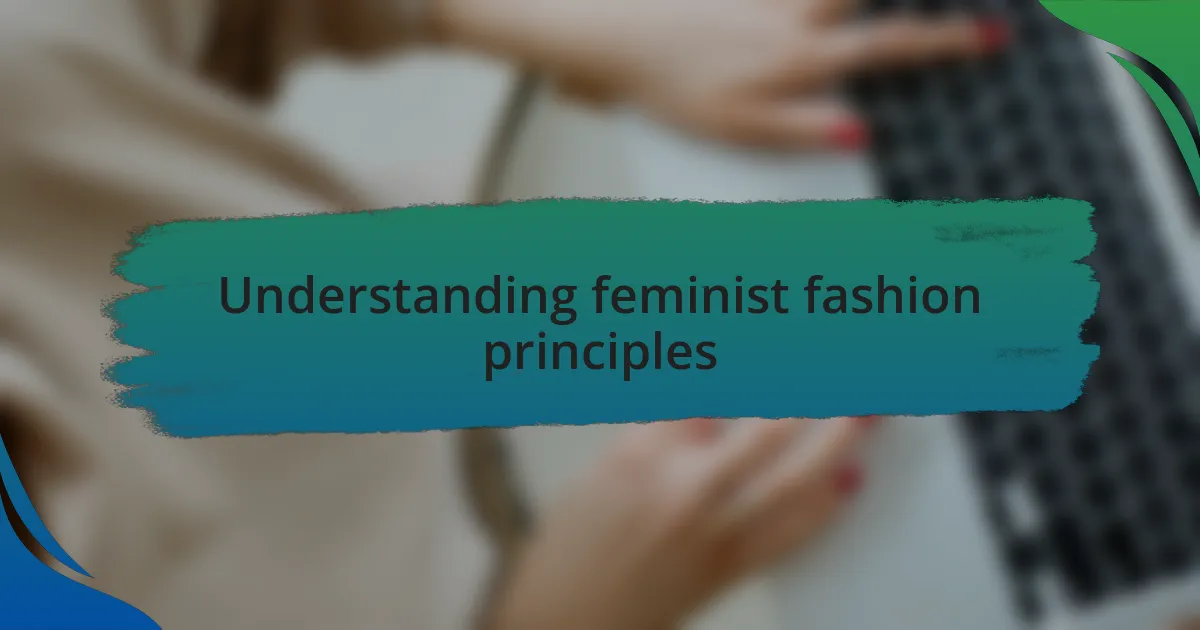
Understanding feminist fashion principles
Feminist fashion principles are grounded in the idea of empowering individuals through clothing choices that reflect personal identity and resistance to societal norms. I still remember the first time I wore a t-shirt emblazoned with a feminist slogan; it felt like I was wearing my beliefs outwardly, sparking conversations and connections. This experience made me realize that fashion can serve as a powerful medium for expressing one’s convictions.
At the core of feminist fashion is sustainability and ethical practices, which challenge the fast fashion industry’s detrimental impact on the environment and marginalized laborers. When I chose to repurpose an old activist garment into a new outfit, I felt an exhilarating sense of purpose—transforming what could have been discarded into something meaningful. Isn’t it incredible how our clothes can tell a story, merging past activism with present creativity?
Moreover, feminist fashion encourages inclusivity and diversity, allowing everyone to find their place within this vibrant community. I’ve often found solace in shared spaces where women and non-binary individuals express themselves freely, embracing different body types and styles. So, the next time you consider your wardrobe, think about how each piece can contribute not just to your image but to the larger conversation about equality and liberation.
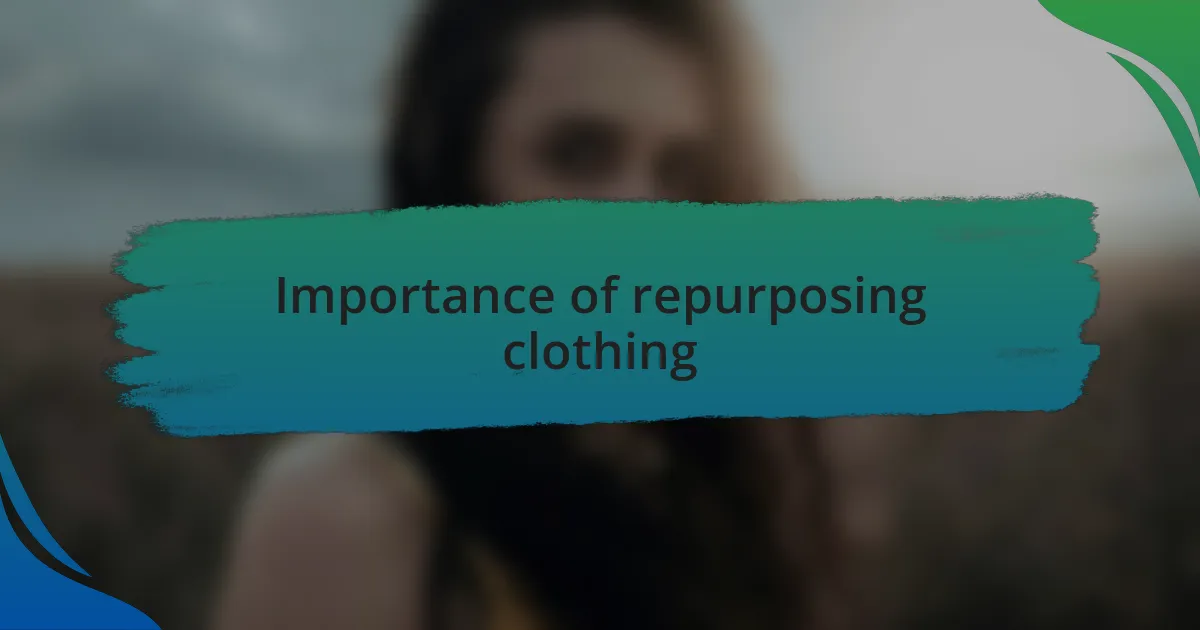
Importance of repurposing clothing
Repurposing clothing plays a crucial role in reducing textile waste, a significant issue in today’s fashion industry. Every time I creatively transform an old garment, I’m not just giving it new life; I’m participating in a movement that actively combats environmental degradation. It makes me wonder—how many pieces in our closets could do the same if given a second chance?
Beyond environmental impact, repurposing garments also preserves the stories woven into the fabric of activism. When I turned an outdated political tee into a trendy tote bag, I felt an emotional connection to the message it carried. It reminds me that clothing can serve as a canvas for our beliefs and a tangible reminder of the struggles and victories surrounding our causes.
Furthermore, engaging in repurposing fosters self-expression and individuality. With each renovation, I find a sense of ownership in the creation process, leading to a wardrobe that truly reflects my identity. Isn’t it empowering to wear something that isn’t just another fast-fashion item, but rather a piece of art imbued with personal meaning?
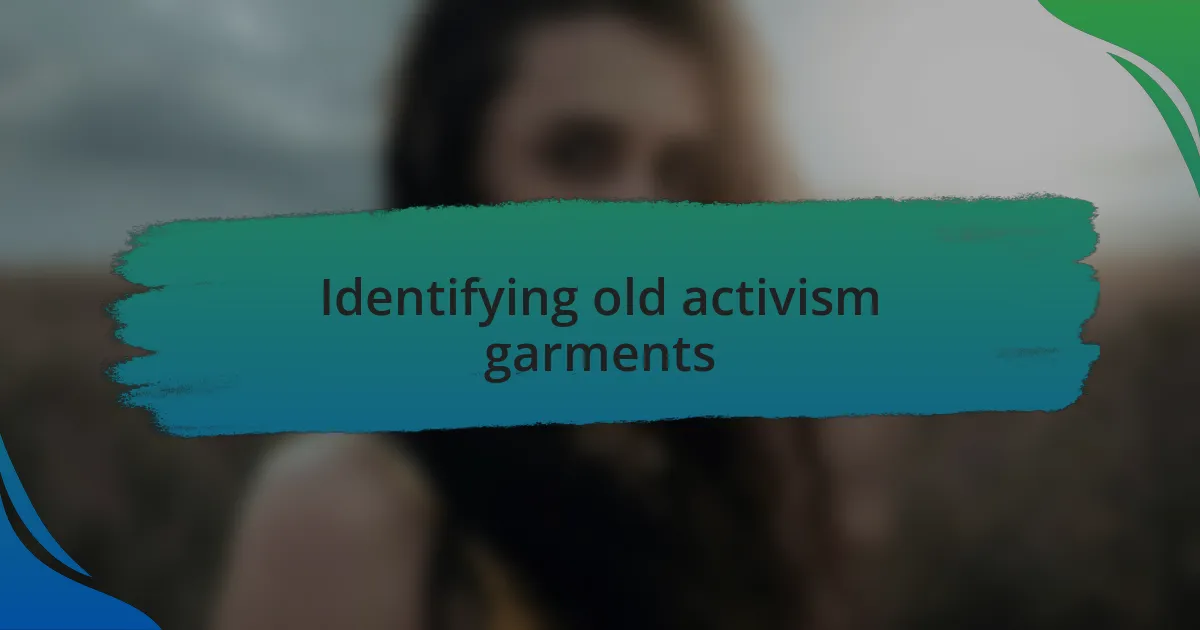
Identifying old activism garments
Identifying old activism garments is often about recognizing the stories and messages they carry. Recently, I stumbled upon a faded button-up that once displayed a bold slogan from a local women’s march. Holding it in my hands, I felt a wave of nostalgia; it wasn’t just fabric but a piece of history that spoke of community and resilience.
As I sorted through my closet, I discovered that random items, like a simple denim jacket, could evoke strong memories. That jacket had patches from various rallies, each one representing a different cause I believed in. It’s fascinating to think about how everyday clothing can serve as reminders of our passions and commitments, urging us to reengage with those ideals.
One important aspect of identifying these garments is their emotional resonance. When I came across an old T-shirt promoting environmental activism, it hit me — wearing it revived my commitment to sustainability. Can you imagine how powerful it is to not only wear a garment that reflects your values but also to transform it into something new? This process allows us to celebrate our activism while creating unique statements in our everyday fashion.
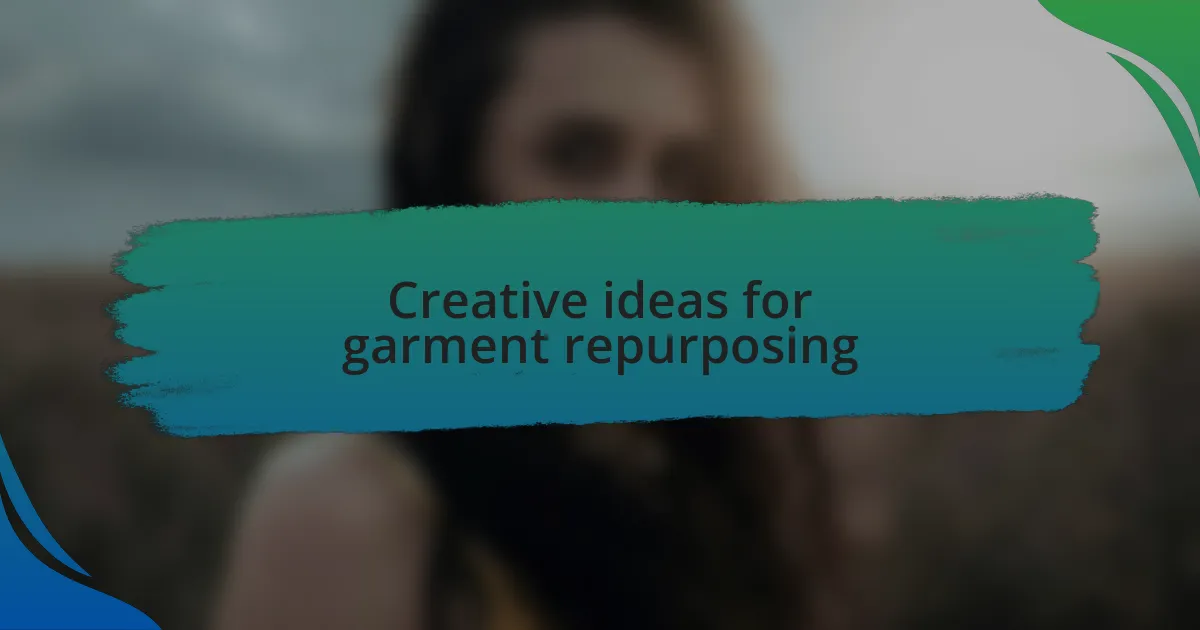
Creative ideas for garment repurposing
Repurposing old activism garments opens up a world of creative possibilities. I once transformed a worn-out protest hoodie into a stylish tote bag. The process wasn’t just practical; it felt deeply rewarding to breathe new life into something that once stood for change. Have you ever considered how a simple cut and stitch can turn a reminder of struggle into a daily utility?
Another idea I explored was creating decorative wall art from old banners. I took a few from a women’s rights rally and stretched them over canvases. Each piece now hangs in my home, a vibrant reminder of the causes I care about. It got me thinking—what if we could fill our living spaces with symbols of empowerment? This not only showcases our values but also opens up conversations with visitors about meaningful issues.
One of my favorite projects involved turning old T-shirts into a quilt. Stitching together pieces that once represented different movements gave me a sense of unity and purpose. It was exciting to think that every square would spark a memory or conversation. Have you ever thought about how much warmth and connection a patchwork of shared experiences can bring? Each garment carries a story, and by repurposing them, we honor those stories while creating something unique and personal for our lives.

Techniques for altering garments
Altering garments requires a blend of creativity and practicality. One method I’ve found particularly effective is upcycling denim. I took an old pair of activist jeans, cut them into a stylish patchwork skirt, and paired it with fabric from an old banner. The result? A vibrant piece that not only looks modern but tells a story of resilience. Have you thought about how your old clothes could be transformed into something fresh and new?
Another interesting technique is dyeing. I recently experimented with tie-dye on a faded activism shirt that I loved but felt had lost its charm. The colors transformed it completely, and each swirl was a reminder of the energy and passion I felt in those moments. This process not only revitalized the fabric but allowed me to express my emotions and experiences in a visual way. Isn’t it fascinating how a splash of color can reignite a memory?
Sewing requires patience, but it can also be a meditative practice. I remember sitting with a stack of old shirts, each one representing a different event I attended. As I carefully removed the seams to create new styles, I found myself reflecting on the meanings behind each piece. I think it’s rewarding to stitch fragments of the past into a new narrative. Have you ever considered how the act of altering could be an extension of the activism those garments once represented?
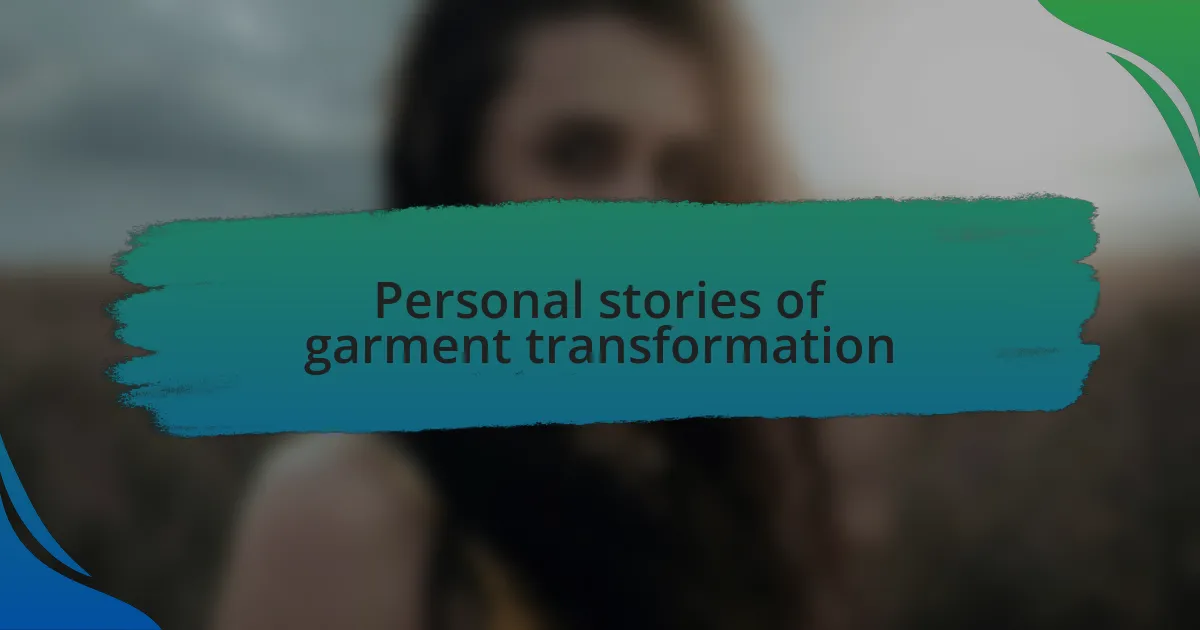
Personal stories of garment transformation
When I found an old activist hoodie tucked away in my closet, it was like unearthing a memory. Rather than letting it gather dust, I decided to turn it into a tote bag for my weekend farmers’ market trips. Each time I carry it, I’m reminded not only of the causes that mattered but also of the commitment to sustainability that inspires my everyday choices. Have you ever repurposed something and felt those memories reignite?
One time, I took a vintage protest t-shirt that had seen better days and transformed it into a chic headband. As I crafted it, I could almost hear the chants and feel the energy from marches past. Wearing it not only keeps my hair in check but serves as a daily reminder to stand up for what I believe in. Isn’t it incredible how a small piece of fabric can evoke such powerful emotions?
In another moment of upcycling inspiration, I turned an oversized jacket from a climate march into a cozy blanket for my living room. I spent hours carefully cutting and sewing, thinking about the conversations and plans it had witnessed. Now, every time I curl up on the couch, I’m wrapped in not just warmth but a tangible connection to my values and community. Doesn’t it feel meaningful when the items we own carry stories with them?
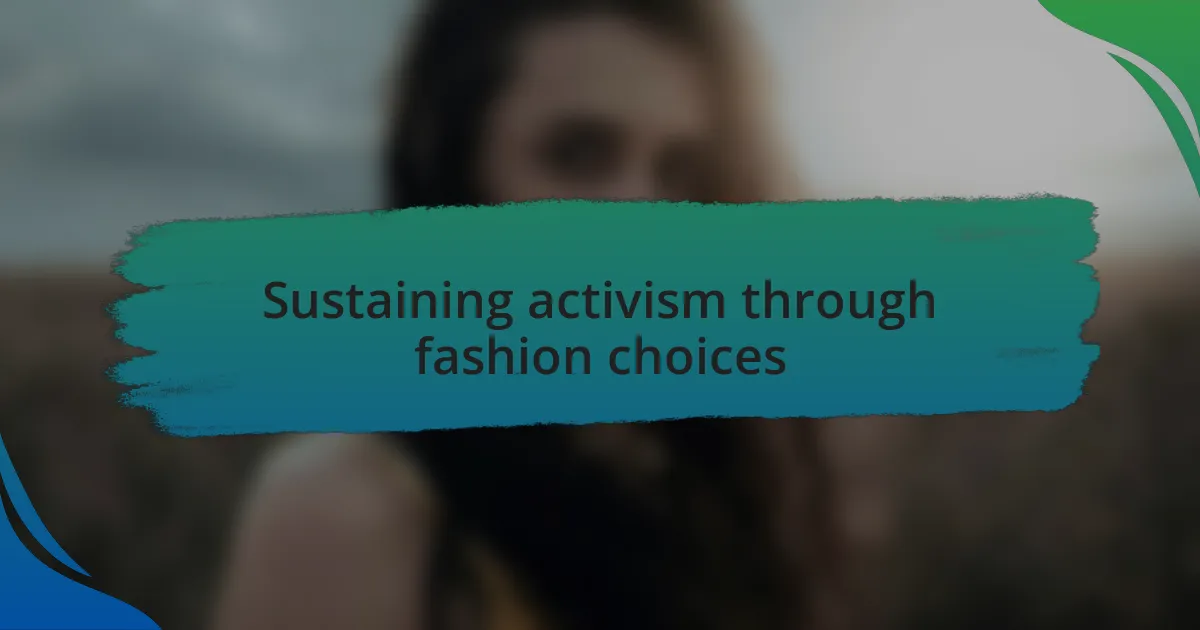
Sustaining activism through fashion choices
The choices we make in our wardrobe can be powerful statements of our beliefs and values. I remember transforming an old activist banner into a patchwork skirt, each square representing a different cause I’ve stood for. Every time I wear it, I feel a sense of purpose, as if I’m weaving together my past protests with my current commitment to activism. Have you ever thought about how your clothes can serve as a reflection of your journey?
I once sewed patches from various campaigns onto a simple jacket, creating a personalized canvas of my activism. With each stitch, I felt like I was reaffirming my dedication to the issues I care about. It’s a conversation starter, too; friends often ask about the patches, and I share my experiences and passions. Isn’t it enlightening how clothing can bridge connections and foster discussions that matter?
Sustaining activism through fashion choices is also about mindful consumption. I learned to look for second-hand items that resonate with my beliefs—a thrifted shirt from a women’s rights march, for example. By choosing to repurpose these garments, I not only breathe new life into them but also contribute to a culture of sustainability. How can we make our wardrobes a testament to our values while reducing waste? It’s an ongoing journey for me, and I’m excited to see where it leads next.